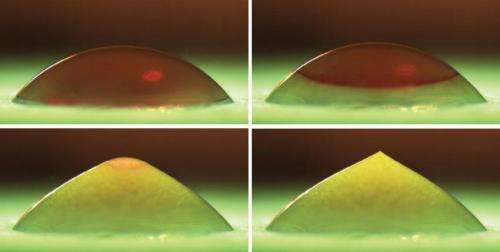Explaining the shape of freezing droplets

A water droplet deposited onto an icecold surface clearly has more effect than a drop in the ocean: the droplet will freeze in a peculiar way, forming a pointy tip. Scientists of the University of Twente have, in cooperation with colleagues from Paris, Brussels and Munich, found an explanation for this remarkable shape. They used video images and advanced mathematics for this. Insight into this process is also useful for understanding processes like 3D printing. The results are published in the August 1 issue of Physical Review Letters.
It is typically a 'do try this at home' experiment that can be performed using a deep-frozen plate (colder than minus 15 degrees Celsius, preferably) and some water at room temperature. A droplet falling on the plate, will freeze starting at the bottom. It will not stay round, but turn into a conical shape. Existing theories could not explain this shape transformation. In their latest publication, the scientists from the University of Twente now present an explanation. Using their theory, the cone angle can also be calculated. These new insights provide useful information for e.g. icing processes on aircraft wings or for manufacturing technologies like 3D printing, where molten metal drops solidify when hitting a surface.
Looking inside a droplet, to investigate the freezing process, is quite complicated. The droplet acts as a lens and distorts the 3D image. That's why the researchers found a way to get video images from a 'flat', 2D droplet. Between two closely spaced glass plates, a droplet is released onto the cold surface. The freezing process can then be monitored very well. The video images prove that the freezing front always has a 90 degrees angle with the water surface. The consequence is that the front turns from spherical to concave. As ice takes about 10 percent more volume than water, in the end ice finds a 'way out' via a pointy tip. Calculations show that this cone angle is always circa 140 degrees, indepent of drop temperature or size.
This research has been done by Oscar Enríquez and Jacco Snoeijer of the University of Twente, The Netherlands, together with colleagues from the Universität der Bundeswehr in Munich, the Laboratoire Matière et Systemes Complexes in Paris and the Université Libre in Brussels.
More information: 'Universality of Tip Singularity Formation in Freezing Water Drops', Physical Review Letters 113, August 1, 2014. DOI: 10.1103/PhysRevLett.113.054301
Journal information: Physical Review Letters
Provided by University of Twente



















